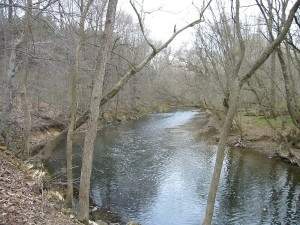
Childhood memories are intense. They can last into adulthood. One memory I haveconcerns a trip to see my grandparents. They lived in Manayunk, PA. I lived in Camden County, NJ. Toward the end of the trip, we would pass the Wissahickon Creek.
The area of the Wissahickon is beautiful, both for its natural scenery and its architecture. Especially so for the Henry Street Bridge. I was about ten years old at the time, in 1958. I had a deep interest in rock hounding, so I would gaze admiringly at the Wissahickon Creek. Just the same, we never did stop there. What was it that fascinated me so? The Wissahickon’s garnet schist.
Wissahickon Creek Garnet Schist
Soft Wissahickon garnet schist consists of silvery flecks of mica combined with very tiny brownish-red garnet stones. Garnet¹, of suitable size and quality is a semi-precious stone. Although the tiny stones embedded in the schist are not of gem quality, the stone is still beautiful. Consider this example shown at Mindat.org.
The composite stone of quartzite and garnet schist was once used in architectural construction. But there is more to the Wissahickon Creek – garnet story!
Gi-normous Stones
Collectors especially value some of the large stones obtained from the Wissahickon area. I’ve never been fortunate enough to own one of them, but here are a couple of images that aptly illustrate why they are so popular.
Almandine Garnet from the Creek
In Conclusion
Now my grandparents are all dead and gone and I live many miles away. If you get a chance to visit the Wissahickon area, be sure to take time to properly enjoy its many sites. It will be time well spent.
¹ Garnet is a form of ferrous aluminum silicate, generally written as Fe₃Al₂(SiO₄)₃
Note: You might also enjoy Euthanasia (Mercy Killing) in 1904 Pennsylvania
References:
- The Virtual Geologic Tour of Wissahickon Creek
- Friends of the Wissahickon
- Garnets in the Fairmount Park area of Philadelphia Pennsylvania
← Back to Classic Science
← Home